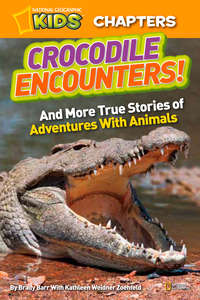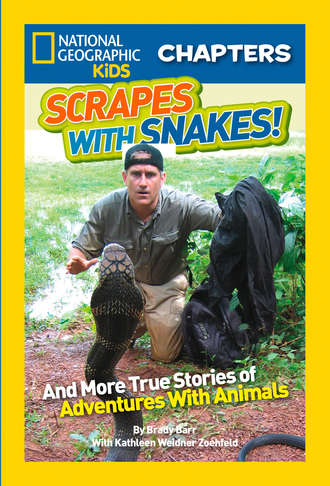
Полная версия
National Geographic Kids Chapters: Scrapes With Snakes: True Stories of Adventures With Animals

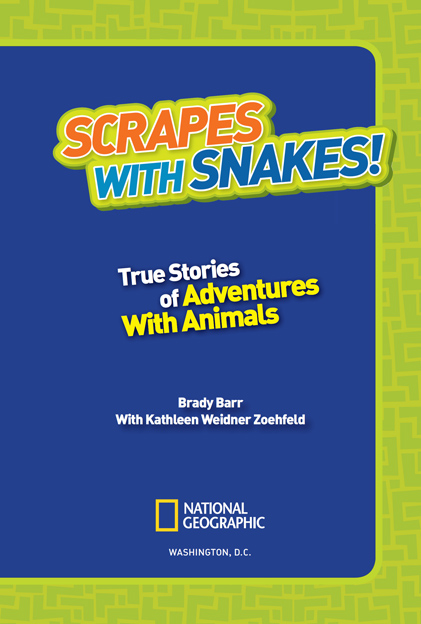
Copyright © 2015 National
Geographic Society
All rights reserved. Reproduction of the whole or any part of the contents without written permission from the publisher is prohibited.
Published by the National Geographic Society
Gary E. Knell, President and Chief Executive Officer
John M. Fahey, Chairman of the Board
Declan Moore, Executive Vice President; President, Publishing and Travel
Melina Gerosa Bellows, Publisher and Chief Creative Officer, Books, Kids, and Family
Prepared by the Book Division
Hector Sierra, Senior Vice President and General Manager
Nancy Laties Feresten, Senior Vice President, Kids Publishing and Media
Jennifer Emmett, Vice President, Editorial Director, Kids Books
Eva Absher-Schantz, Design Director, Kids Publishing and Media
Jay Sumner, Director of Photography, Kids Publishing
R. Gary Colbert, Production Director
Jennifer A. Thornton, Director of Managing Editorial
Staff for This Book
Shelby Alinsky, Project Editor
Hillary Leo, Photo Editor
Callie Broaddus, Art Director
Ruth Ann Thompson, Designer
Grace Hill, Associate Managing Editor
Michael O’Connor, Production Editor
Marfé Ferguson Delano, Editor
Paige Towler, Editorial Assistant
Erica Holsclaw, Special Project Assistant
Allie Allen and Sanjida Rashid, Design Production Assistants
Margaret Leist, Photo Assistant
Lewis R. Bassford, Production Manager
Susan Borke, Legal and Business Affairs
Production Services
Phillip L. Schlosser, Senior Vice President
Chris Brown, Vice President, NG Book Manufacturing
George Bounelis, Senior Production Manager
Nicole Elliott, Director of Production
Rachel Faulise, Manager
Robert L. Barr, Manager

The National Geographic Society is one of the world’s largest nonprofit scientific and educational organizations. Founded in 1888 to “increase and diffuse geographic knowledge,” the Society’s mission is to inspire people to care about the planet. It reaches more than 400 million people worldwide each month through its official journal, National Geographic, and other magazines; National Geographic Channel; television documentaries; music; radio; films; books; DVDs; maps; exhibitions; live events; school publishing programs; interactive media; and merchandise. National Geographic has funded more than 10,000 scientific research, conservation, and exploration projects and supports an education program promoting geographic literacy.
For more information, please visit
www.nationalgeographic.com, call 1-800-NGS LINE (647-5463), or write to the following address:
National Geographic Society
1145 17th Street N.W.
Washington, D.C. 20036-4688 U.S.A.
Visit us online at
www.nationalgeographic.com/books
For librarians and teachers:
www.ngchildrensbooks.org
National Geographic supports K–12 educators with ELA Common Core Resources. Visit natgeoed.org/commoncore for more information.
More for kids from National Geographic:
kids.nationalgeographic.com
For rights or permissions inquiries, please contact National Geographic Books Subsidiary Rights: ngbookrights@ngs.org
Trade paperback
ISBN: 978-1-4263-1914-3
Reinforced library edition
ISBN: 978-1-4263-1916-7
eBook ISBN: 978-1-4263-2224-2
v3.1
Version: 2017-07-11
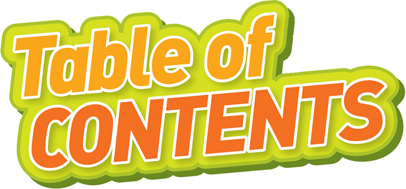
Cover
Title Page
Copyright
THE SNAKE THAT ATE COWS!
Chapter 1: Snake Problem!
Chapter 2: Swamp Slog
Chapter 3: Wrestling a Giant
ROBO-WEASEL
Chapter 1: Not Going in There!
Chapter 2: Fishing for Snakes
Chapter 3: Rescuing Robo-Weasel!
SNAKE ON A STRING
Chapter 1: The Snake Palace
Chapter 2: A Brilliant Plan
Chapter 3: Follow That String!
SOCK HEAD
Chapter 1: Biggest of the Big
Chapter 2: Find Them With Your Feet!
Chapter 3: Photo Op!
DON’T MISS!
More Information
Dedication
Credits
Acknowledgments
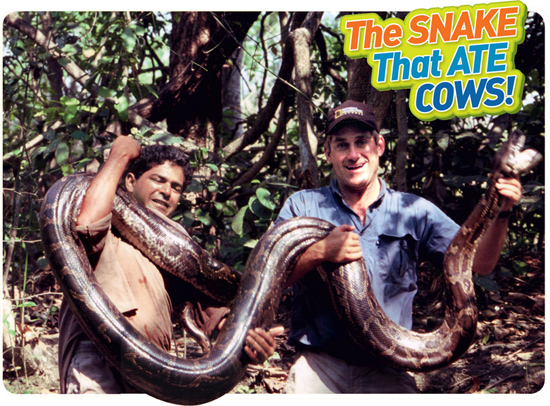
That’s me, Brady Barr, with my friend Gerry Martin on the left. Together, we caught this giant Indian rock python.
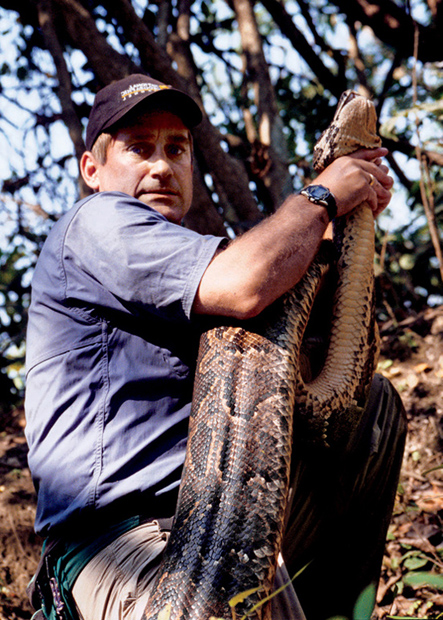
When catching a snake this big, it’s always best to secure its head first. That’s the biting end!
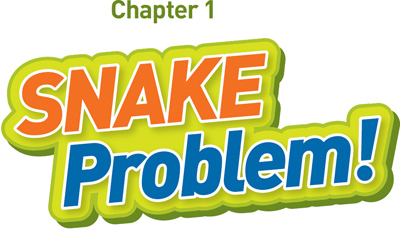
I was waist-deep in water in a muddy swamp. I was trying not to think about the leeches that might be crawling up my legs. Then—I spotted it! Stretched out in front of me was the biggest snake I had ever seen. It looked as long as a bus!
What was I doing here? My name is Brady Barr. I’m a zoologist (sounds like zoh-AH-luh-gist), a scientist who studies animals. I’ve studied all kinds of animals all over the world. My favorites are reptiles—really big reptiles.
I’ve worked with some real giants. I’ve wrestled crocodiles over 18 feet (5.5 m) long. I’ve captured 10-foot (3-m)-long lizards and turtles the size of small cars.
But until that day in the swamp, I’d never come across a giant snake. Although they’re among the biggest reptiles on the planet, they’re very hard to find. And scientists know surprisingly little about them.
The swamp where I met the giant snake was in northern India. I was there with my friend Gerry Martin, a reptile expert. We had teamed up to study a rare and endangered crocodilian (sounds like krah-koh-DIL-ee-un). But our croc project soon took an unexpected turn.
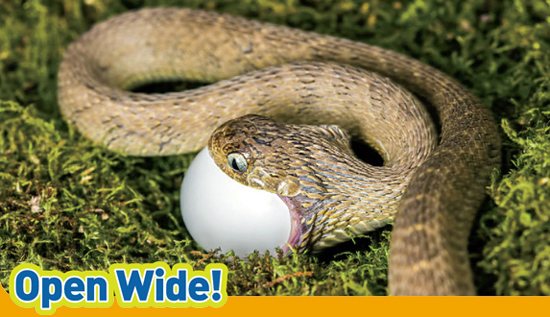
(photo credit 1.1)
Some snakes can swallow things three times the size of their own head! How do they do it? Snakes have really flexible jaws. Human jaws are attached to the skull like a door on hinges. All we can do is open and shut them. A snake’s lower jaw is not solidly attached at the chin, like ours is. Each side can move separately. A snake’s jawbone is attached to the skull by stretchy bands of tissue, almost like rubber bands. Using its curved teeth to grip its prey, the snake can slowly stretch out its jaws and move its mouth around its meal.
When Gerry and I got to the small village near our research site, none of the people wanted to talk about crocs. All they wanted to talk about were snakes. They said they had a big problem. Their cows were disappearing. And they believed a giant snake was eating them.
Did You Know?
In The Jungle Book, by Rudyard Kipling, the giant, 100-year-old snake named Kaa is an Indian rock python.
Holy cow! I thought. A cow-eating snake?
This was a story we just had to look into. A snake large enough to eat a cow would have to be a true giant. We’d heard stories like this before. But no scientists had ever been able to check them out. Maybe this was our chance to prove those stories were true.
The villagers told us the giant snake was eating their dogs, cats, and goats, too. They hoped maybe we could catch this snake and take it away to a safe place, far away from the village.
Gerry and I thought the snake was probably an Indian rock python. Rock pythons live in many different habitats. You can find them in low grasslands and on high mountain slopes. But the real giants usually stay near water.
The village was near the Geruwa (sounds like jeh-ROO-wah) River. Gerry wanted to go straight to the swampy area closest to the river, where the water was deepest. It was a great place for a big snake.
I really wanted to see this giant. But I wasn’t so sure I wanted to get into a deep, muddy swamp with it!
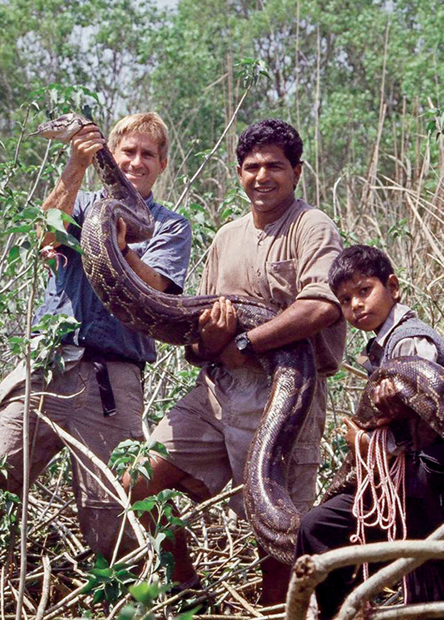
Ten-year-old Ramkrishna helped Gerry and me find the huge snake.
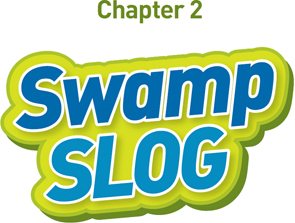
Indian rock pythons can grow to more than 20 feet (6 m) long.
They are incredibly strong. A python has more than 10,000 muscles (sounds like MUH-sels) in its body. Humans have fewer than 1,000. Pythons are constrictors (sounds like kun-STRICT-ers). That means they use their muscles to squeeze, or constrict, their prey.
When a python sees an animal it wants to eat, it strikes out with lightning speed. It latches on to it with needle-sharp teeth. The teeth curve backward, toward the snake’s throat. Once an animal is caught in those teeth, it cannot pull away. The snake instantly coils around it and squeezes. When the prey has died, the python opens its mouth wide and swallows it whole.
A snake big enough to swallow a cow could certainly swallow a man! With this thought in my head, I waded into the dark water. I had never seen a truly giant snake in the wild before. But I knew it would be better to find it before it found me. I did not want to experience a python’s big squeeze.
Gerry and I searched for a long time without seeing anything. Then we decided it might be better if we split up. That way we could search more ground—or swamp, that is. Pretty soon, I heard Gerry shouting, “Snake! Snake! Snake!” I nearly jumped out of my skin.
I slogged toward Gerry through the knee-deep water. Peering through the tall grass, I could see he had a small, three-foot (1-m)-long python in his grasp. This was very cool. But I was expecting something a little larger. This couldn’t be the cow-eater, that’s for sure. We split up again and kept searching. After several hours, all we’d found were three more small pythons.
Exhausted, we sat on the riverbank and picked the leeches off our bare legs. After all our effort, we had found only four small snakes. We felt frustrated.

(photo credit 2.1)
A snake smells with its nose, like humans do.
But a snake has another secret weapon in the world of smell—its forked tongue. A snake flicks its tongue in the air. The two tips pick up tiny particles of odor. When the snake pulls its tongue in, the odor particles are delivered to a special organ on the roof of its mouth, called the Jacobson’s organ. This helps the snake identify the odors. Together, the nose and Jacobson’s organ make the snake a super smeller!
We wanted to get back to the croc study we’d come to India for in the first place. We were both thinking this giant snake story was simply that: a tall tale! We had about decided to call it quits, when a small boy, about ten years old, came up to us. His name was Ramkrishna (sounds like ram-KRISH-nah). He had been watching us all day. He said that he really liked snakes. And he told us we were looking for the snake in the wrong spot.
Ramkrishna said the big snake liked to hang out in another part of the swamp, in an area farther from the river. Gerry wasn’t so sure. He still felt we’d find the snake closer to the river. He said he was going to take one more look.
I decided to check out the area Ramkrishna told us about. So, Gerry and I separated again for one last slog through the muck. We agreed to meet up at our truck before sunset.
By now, I was pretty sure there was no giant cow-eating snake. I was feeling a lot more relaxed in the swamp. But I was not crazy about the leeches! I was trudging along, wondering if any of those slimy little things were crawling on me again. I reached down to scratch my leg. And when I looked up, there it was! I froze in disbelief. I was horrified and fascinated at the same time. Never in my life had I seen a snake so big!
Ramkrishna had been right. Farther from the river, the snake had found a nice spot to come out of the water. Here it could warm up in the sunshine. But it could slide back into the water quickly, if it needed to.
At first, I thought maybe the snake was asleep in the warm sun. But there’s no way to know for sure if a snake is asleep. Snakes don’t have eyelids, so their eyes are always open.
Did You Know?
Like sharks and crocodiles, snakes lose teeth and grow in new ones throughout their lives.
I watched for any little movement. Suddenly, I saw the snake’s long forked tongue flick out. It waved around in the air in long, drawn-out motions.
Uh oh! I thought. It knows I’m here! Snakes use their forked tongues to pick up odors. And right now that giant was smelling me.
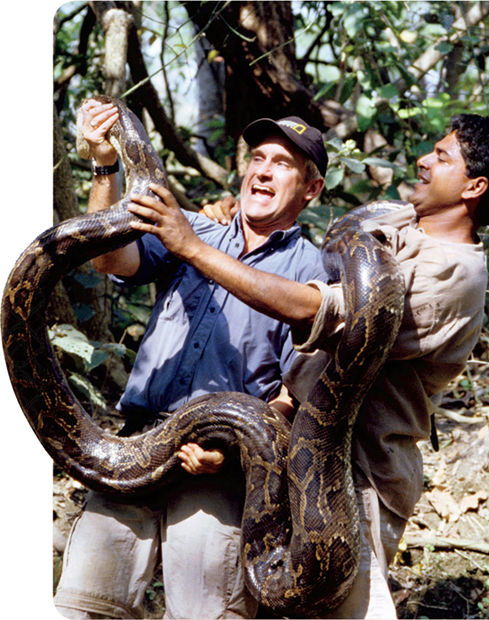
After a long battle, Gerry and I posed with our prize. I always release the snakes I catch back into the wild.
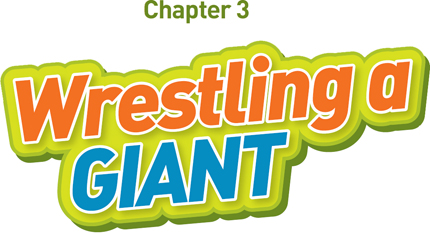
My brain began racing with scary thoughts. I was only a few feet away from an animal that could swallow me whole. If it decided to strike, I wouldn’t be able to move away fast enough.
“Snake! Giant snake! Giant snake!” I yelled. I was startled by the sound of my own voice in the silent swamp.
I knew my screams wouldn’t startle the snake, because snakes don’t have ears like we do. But I sure hoped Gerry was close enough to hear me.
With my eyes still glued to the snake, I heard Gerry slogging toward me. When he spotted the giant python, his eyes grew as big as plates.
Gerry had more experience with big snakes than I had. But he had never seen one this large. “We have to catch it!” he shouted.
“Catch it?” I cried. “Are you kidding me? That thing could eat us both for lunch.” I had a better idea: Let’s not catch it. Let’s run for our lives. But I kept that thought to myself. I knew Gerry was right. We had to try and capture this snake before it got into any more trouble. If it did, the villagers might harm it.
“On the count of three, jump on it,” Gerry said. “I’ll go for the head. You secure the body.”
Secure the body? I thought. That snake looks a lot stronger than I am. Still, that sounded easier than trying to grab the toothy end. There’s nothing fancy about catching a big snake. Just jump on top of it and hang on. And avoid the mouth. It’s just a matter of muscle against muscle. Or in this case, our combined total of less than 2,000 muscles against the snake’s 10,000!
Конец ознакомительного фрагмента.
Текст предоставлен ООО «ЛитРес».
Прочитайте эту книгу целиком, купив полную легальную версию на ЛитРес.
Безопасно оплатить книгу можно банковской картой Visa, MasterCard, Maestro, со счета мобильного телефона, с платежного терминала, в салоне МТС или Связной, через PayPal, WebMoney, Яндекс.Деньги, QIWI Кошелек, бонусными картами или другим удобным Вам способом.


